Keeping Dead Wood and Creating Wildlife Habitat Piles: Some Guidance for Forest Owners
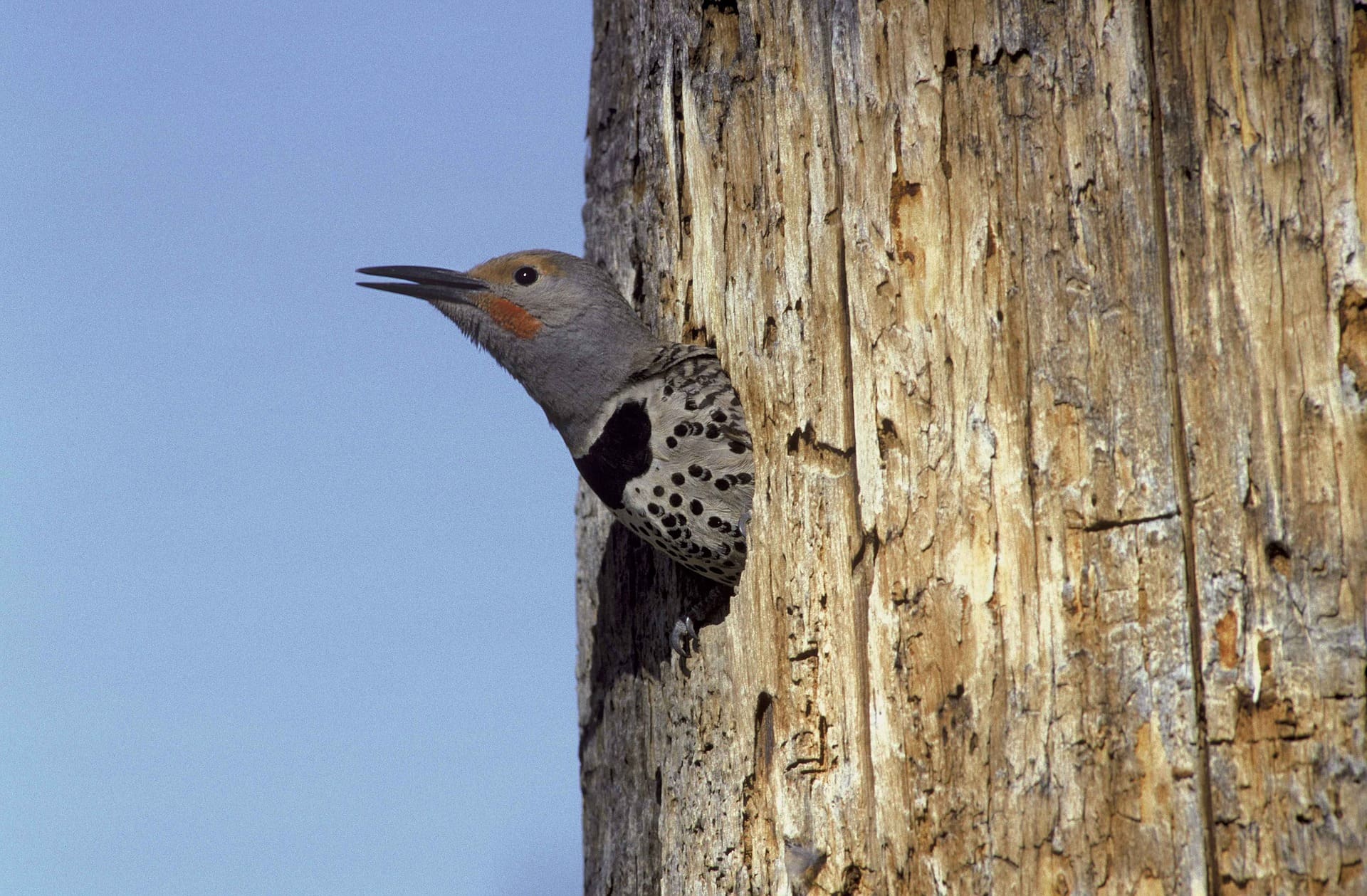
One of the most important decisions you can make to promote wildlife habitat is to keep snags and down wood in your forest.
Snags, large down logs, and big decadent trees provide food and shelter to more than 40 percent of wildlife species in Pacific Northwest forests. This coarse woody debris provides important structures for cavity-dependent birds and small mammals, food sources for woodpeckers and other foragers, and slowly release nutrients into the ecosystem with the help of decomposers.
Forests naturally include some trees that have succumbed to diseases, pests, storm events, or old age – some disease, decay, and tree death is normal in a healthy forest. Damaged, dead, deformed, and dying trees are hotspots of biodiversity and biological legacies. Second- and third-growth forests often lack sufficient snags and down logs because these materials were removed during previous intensive forest management; or the few remaining are in advanced stages of decay.
Historically, undisturbed lowland westside forests in Oregon and Washington with healthy populations of snag-dependent wildlife species had an average of 10-18 snags per acre and 50-140 down logs per acre in varying states of decay and size.1 Terrestrial amphibians, reptiles, birds, and small mammals depend on large coarse woody debris for protection as well as foraging for insects, fungi, and seeds. Additionally, many species of fungi, moss, lichens, ferns, and invertebrates that form an integral part of a healthy forest depend on dead trees and down woody material for all or a part of their life cycle.
Wildlife biologists consider high-quality snags to be standing dead conifers with diameters that are 12 inches or larger. Cavity-nesting birds like woodpeckers need trees with diameters of at least 25 inches. Large hardwoods such as bigleaf maples and Oregon white oaks also provide snags with large cavities. Conifer snags tend to last longer than hard wood snags, as hardwoods decay faster. The larger the tree, the larger the snag, the better.
Through retention and natural recruitment, manage your forest to include:
- At least 4 down logs per acre that are 20 feet long and 20 inches in diameter – the larger the better
- At least 4 snags per acre that are 20 feet tall and 12 inches in diameter – the larger the better
In the short term, creating wildlife habitat piles and constructed logs can provide some of the functions of dead wood.
Habitat Piles
Wildlife habitat piles are deliberately constructed. They are built with small trees, limbs, and boughs – often with materials that are a byproduct of management activities or storm-related debris. These “critter condos” provide some of the functions of large down logs found in older forests. Wildlife such as song birds, voles, chipmunks, squirrels, rabbits, salamanders, frogs, lizards, snakes, and insects use piles as dens or nesting spots, to shelter from bad weather, to escape predators, and to forage.
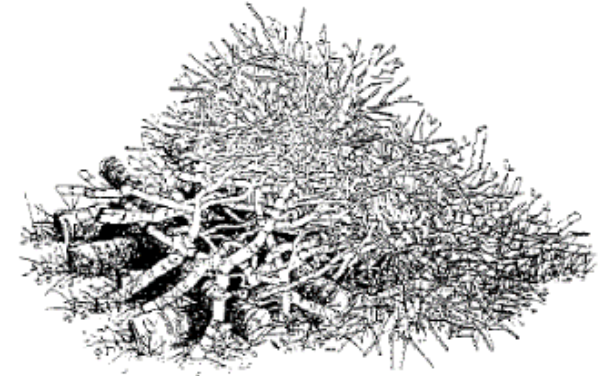
Design Recommendations
These recommendations are intended to help build habitat piles with long term viability. With some maintenance every few years, piles can last as long as 10 years.
Wildlife can use habitat piles of any size, but biologists recommend building piles that are 10 to 12 feet across at the base and about 6 feet tall. To make one, place large poles (at least 4 inches in diameter) on the ground in 4 to 6 perpendicular (crisscross) layers. Larger materials go into the lowest layers that form the base and help provide tunnels for smaller creatures to escape predators.
Add finer material on top – at least 18 inches deep which might require 6 to 10 layers of branches and boughs. Smaller material such as branches and boughs can provide ground nesting birds with forage, cover, and even nest sites.
Aim for 2 to 3 piles per acre, about 100 feet apart.
Pro-tip: Avoid using green (recently pruned) Douglas-fir or ponderosa pine boughs in the piles from January to August to avoid attracting undesirable beetles to your forest – wait for these branches to dry a season before adding them into a pile.
Who uses habitat piles?
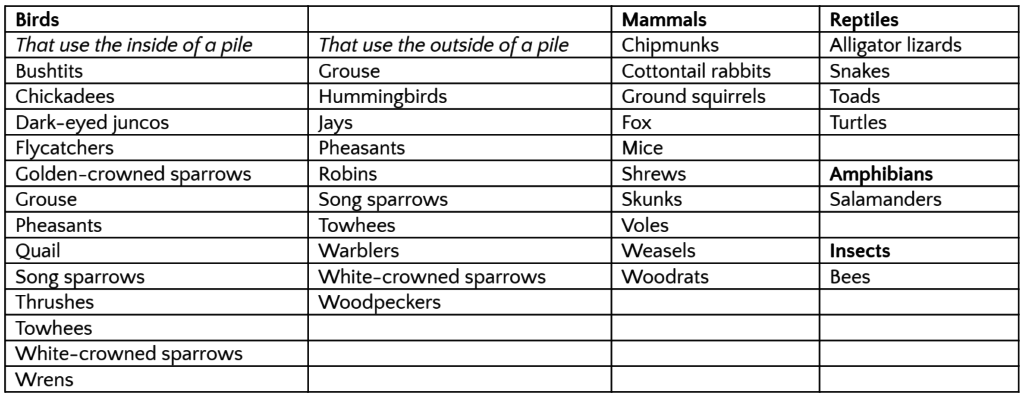
Constructed Logs
If your forest is short of large down wood, then “construct” some. After a storm event or young stand thinning occurs, bundling small-diameter trees together lengthwise can provide some (but not all) of the functions of larger rotting logs. These constructed logs can help retain moisture, accumulate leaf litter and debris – making for micro-environments that are conducive for fungi and insects and thereby attracting other wildlife.
In areas with a shortage of large down wood, some restoration specialists will place cribs of constructed logs in wetlands and flood plains. The goal is for these constructed logs to provide some of the functions of larger woody debris such as slowing down the movement of water, allowing for nutrient accumulation, and providing roosts and resting areas.
Design Recommendations
Use cribbing to stake out the dimensions for the constructed log. The number of stakes used will depend on the length of log you are building and the materials used. Lay the small diameter poles parallel to each other in the cribbing to shore up the log. Constructed logs should be 12 to 20 feet long and about 2 feet wide. Aim for 2 to 3 “logs” per acre, about 100 feet apart.
Where to Build Habitat Piles and Constructed Logs
- Piles and logs can go in areas with different sun exposure or vegetation types.
- In areas with little rain and hot summers, wildlife will benefit from habitat piles and constructed logs in shade.
- In cooler areas, a habitat pile or constructed log on the edge of a clearing or anywhere with partial sun is beneficial.
- If surface water is available (e.g. streams, wetlands, etc.) try to locate habitat piles within 100 feet in order to benefit amphibians and other aquatic species.
- Avoid installing habitat piles along roads, near bases of trees, in areas that collect cool air or receive excess water, or where the pile will be a fire hazard.
- Aim for 2 to 3 piles or “logs” per acre, about 100 feet apart.
Examples of habitat piles and constructed logs
Base logs going into the lower levels of a habitat pile in construction.
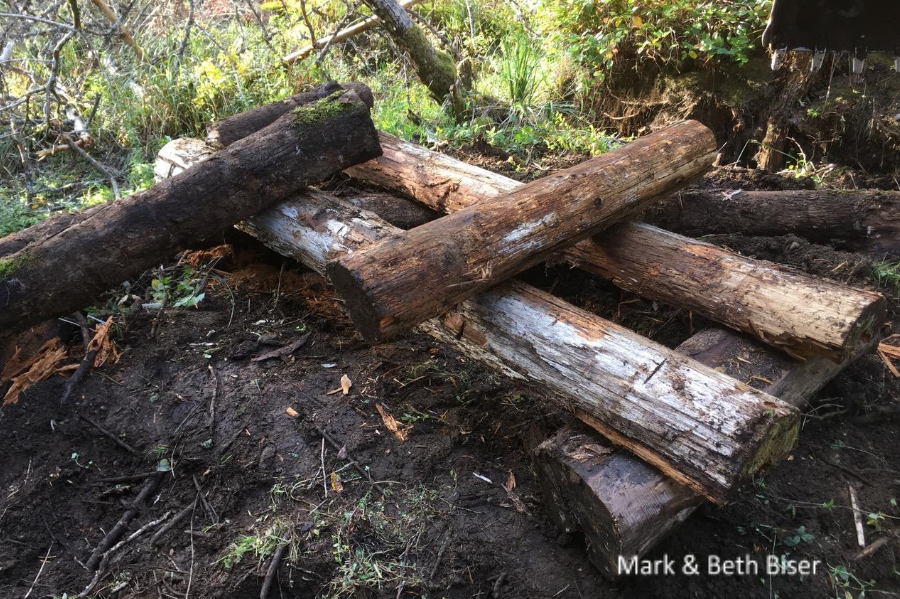
A finished habitat pile with a good 18-24 inches of fine branches and top of the base layers.
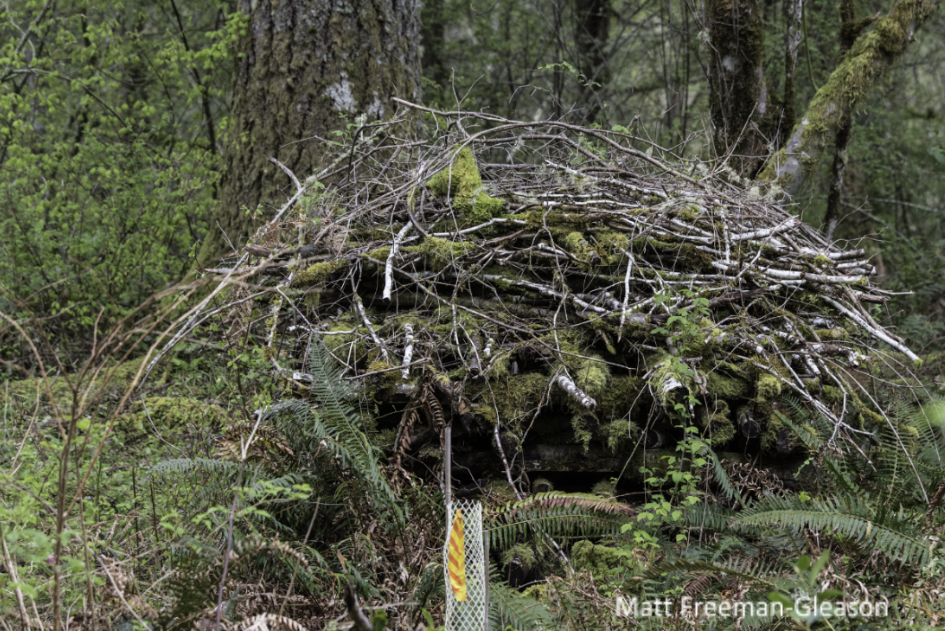
A constructed down log installed in a 4-stake crib as part of a wetland restoration project – in the wet season, this “log” slows the flow of water that flows from the wetland into a nearby stream
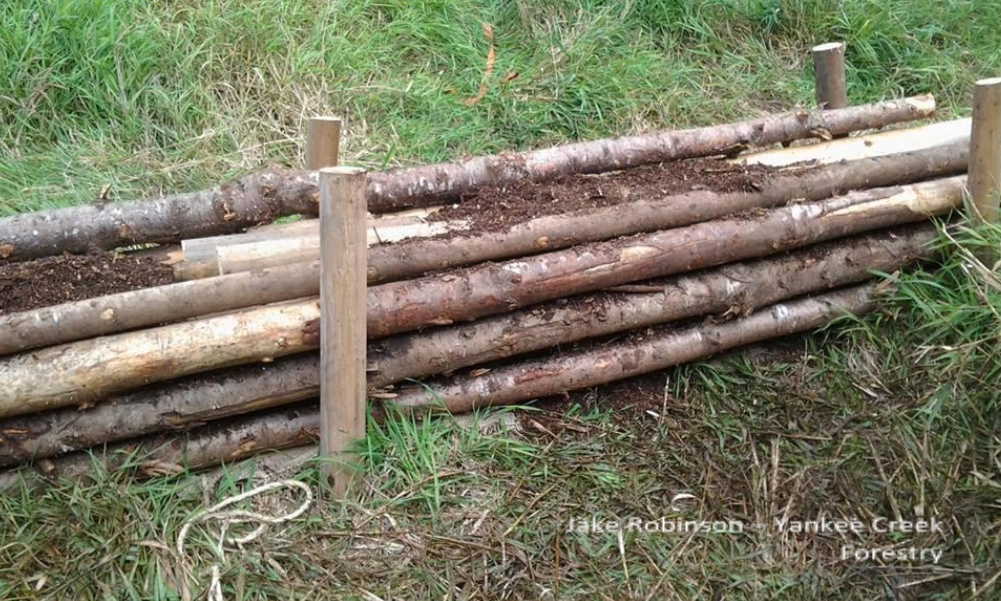
A natural down log – down logs are a source of protection, food, and cover for many small and medium sized animals (micro and macro invertebrates, amphibians, small mammals, birds, insects, and fungi
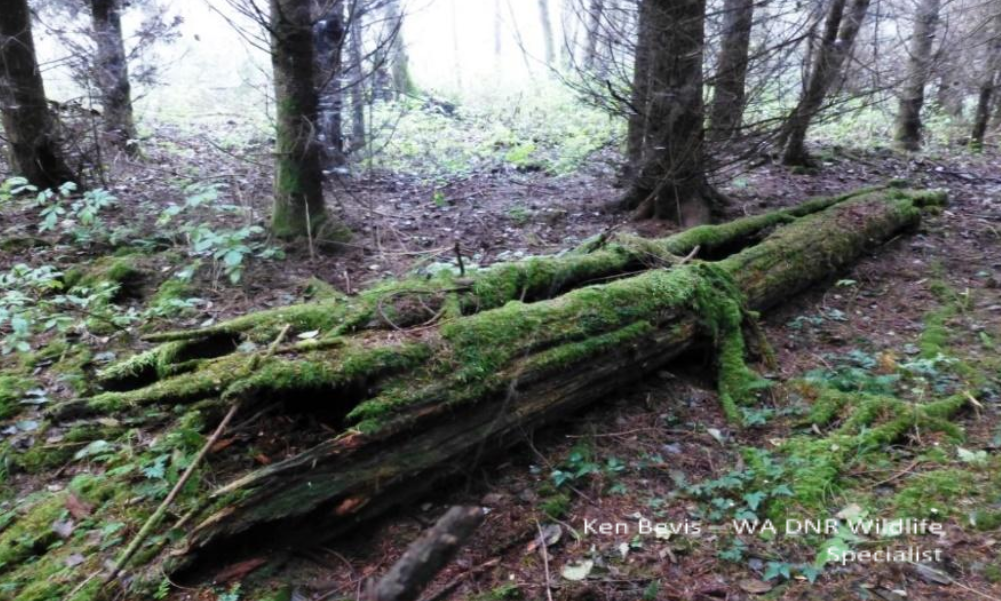
Various stages of decay in snags and down logs
Snags and down logs come in all shapes and forms and varying states of decay. Being able to generally recognize the decay condition of down wood can help with understanding how the down wood is functioning at that time in the forest.
Snags fall into two primary decay class categories:
- Hard snags, with the bark is still intact and with firm heart and sapwoods
- Soft snags, which may have some bark remaining but with the wood beginning to soften
Down logs fall into five primary categories based on their decay class:
- Class 1, bark is still intact and heart and sapwood is still firm
- Class 2, log is in contact with ground; bark is beginning to deteriorate and inner wood is soft
- Class 3, log is in contact with ground; bark has completely fallen off and log is beginning to become incorporated into the forest floor
- Class 4, log is partially buried and wood is very soft
- Class 5, log is barely distinguishable from surrounding forest floor
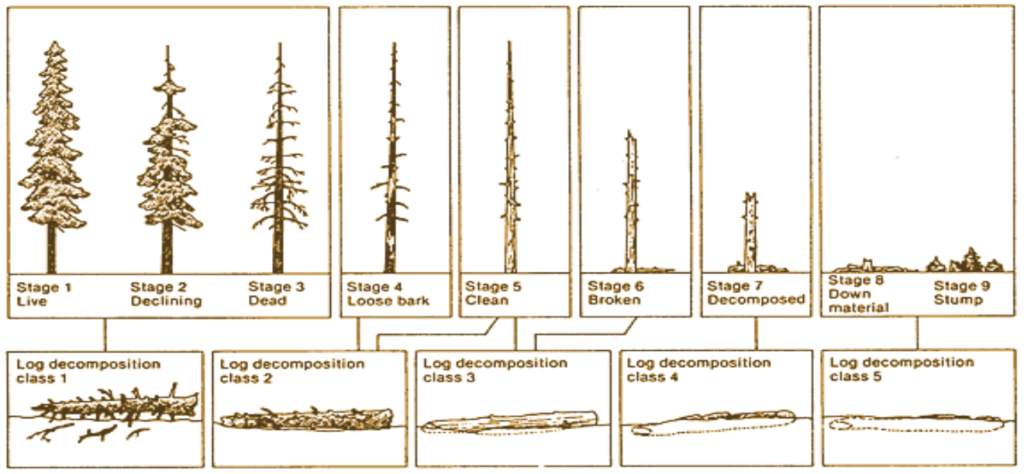
Additional resources
Videos
- NNRG video on building habitat piles: https://www.youtube.com/watch?v=zriS-FDVoG8
- NNRG video on building constructed logs: https://www.youtube.com/watch?v=qB4TSBeKoQ8
Book
Landscaping for Wildlife in the Pacific Northwest by Russell Link. 1999. Seattle, WA: University of Washington Press. 320 pp. http://wdfw.wa.gov/living/book/
Blog Posts
- DNR Blog Post: Not Just Another Stack of Dead Branches: Habitat Piles for Wildlife: https://washingtondnr.wordpress.com/2017/02/14/not-just-another-stack-of-dead-branches-habitat-piles-for-wildlife/
- DNR Small Forest Landowner News: Pile it on! Habitat Piles for Wildlife: https://sflonews.wordpress.com/2017/02/13/pile-it-on-habitat-piles-for-wildlife/
Reports and Publications
- Dead and Down Woody Material, USFS Pacific Northwest Region 6, R. Bartels, J.D. Dell, R.L. Knight, G. Schaefer. In: Brown, E .R., technical editor. Management of wildlife and fish habitats in forests of western Oregon and Washington. Part I—Chapter narratives. PNW R6-F&WL-192-1985. Portland, OR: USDA Forest Service; 171-186.: https://hdl.handle.net/2027/uva.x001989954 https://www.fs.usda.gov/detail/r6/landmanagement/resourcemanagement/?cid=fsbdev2_026700
- DecAID, the Decayed Wood Advisor for Managing Snags, Partially Dead Trees, and Down Wood for Biodiversity in Forests of Washington and Oregon: https://apps.fs.usda.gov/r6_decaid/legacy/decaid/index.shtml
- Forest Biomass Retention and Harvesting Guidelines for the Pacific Northwest: https://www.forestguild.org/publications/research/2013/FG_Biomass_Guidelines_PNW.pdf
- Family Forests and Wildlife: What You Need to Know: http://woodlandfishandwildlife.com/news/family-forests-and-wildlife-vigorous-forests-and-healthy-wildlife/
1 According to the USDA’s DecAID (Decayed Wood Advisor) Decayed Wood Advisor for Managing Snags, Partially Dead Trees, and Down Wood for Biodiversity in Forests of Washington and Oregon: https://apps.fs.usda.gov/r6_decaid/legacy/decaid/index.shtml

7 Comments
Thank you for writing this. Surprisingly, I have not been able to find a quality resource written on this topic (especially in my home state of Ohio).
As a steward for a site with oak/hickory woods that are being restored, here in McHenry Co. Il. and having to fight with a burn it all/clear it all (invasives and forest-floor litter) mentality I am so happy to find you!! Even though your woods are not the same as ours…the principles you talk about are transferable. We are focused on oak regeneration…and keep wondering why, after all the invasives are gone the oaks just don’t seem to want to regenerate. We have many mature oaks, previously shade pruned by buckthorn and Japanese honeysuckle,(now cleared) strangled by (now dead) oriental bittersweet. As we open up the forest floor we hope that things will ‘pop’. There is sooo much that we humans just don’t know about how the earth has done for millions of years!
I am on the west side of the Cascades in Oregon. A remote location where I can pile anything I want any place I want. I would like to promote habitat for the wildlife. But I am worried about the fire danger. Don’t piles of dead wood create a higher fire danger? I have read the recommendations for keeping flammable items and landscaping certain distances from the house. How does this apply to piles of branches in the forest for the wildlife? Is there a certain distance away from the house in the forest where it would not increase the danger? Or does it matter at all since there are already trees everywhere?
Thank you for any help you can give.
Hi Erin,
Creating wildlife habitat piles using fine slash and small diameter logs is a good way to manage excessive woody debris in your forest in a manner that reduces fire risk. By aggregating material into well-spaced piles, you minimize the otherwise dispersed fuels on the forest floor that can allow a fire to spread more rapidly. There are several placement strategies for habitat piles that will further reduce fire risk:
– Space them no closer than 50′ apart
– No pile should be within 100′ of a human structure or public road
– Piles should be placed within a gap in the forest, and well away from other trees. Never place a pile either at the base of a tree or beneath the reach of a tree’s crown.
– Ideal locations for piles are within 100′ of a stream or wetland, which will enhance their functionality as habitat for amphibians.
Thank you so much for your reply. I will follow your advice. And thank you in advance from the quail and grouse. They have been after me for a while to get better accommodations for them. The jackrabbits just scoff, and think the birds are wussy.
Thank you for this information. . . and now, a question.
Are habitat piles a reasonable alternative in the more arid areas east of the Cascades? Our place in eastern Oregon is predominately Ponderosa pine and oak, with not a lot of undergrowth. We are always concerned about wildfires and have had a few close encounters. For years, the solution for disposing of dead branches and trees has been through burn piles, but I have always felt there had to be a more environmentally friendly way. Your article on “habitat piles” is intriguing and I am wondering if it could possibly be at least a partial solution. Thank you for any advise you can give on this subject.
Thanks for your question, Jean! Spacing the piles will be key with fire in mind; you wouldn’t want them too close to each other, to structures, or to trees. We recommend at least a 50-100 foot buffer to isolate the piles from each other and from built structures to minimize fire risk.